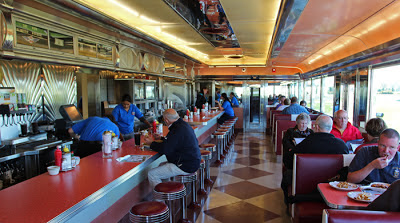GEOCACHING CHALLENGES--AND REWARDS
It is easy to zoom by this rustic track while you are rolling along SR 97 between Butler and the Mohican State Forest. It is even more interesting to stop, park the vehicle and wander into the unknown as the muddy lane (above right) disappears into the woods.
This cemetery dates to the early 1800s when more than 90% of the new state called Ohio was covered by old growth forest and a trail as clear as the one above would have been considered a turnpike of its day.
I suspect most of this cemetery's visitors today are township folks who maintain it or are geocachers like me who are in search of some sort of cache that has been hidden back there with its location in the form of latitude and longitude posted on line to help us find it.
Actually, the travel and the final search are much more interesting in this hobby than what actually is found in the cache; usually just a water-tight container with some trinkets and a log book geocachers sign to prove the success of their search.
My day of searching begins with picking what sound like interesting caches; within a 10 mile radius of a nearby town, for example and loading the coordinates in my car GPS which I then use to find the general location of the cache.
I also download more detailed information on the cache in a hand-held GPS unit which I will use to find the specific location as I walk toward it from the car with the guidance of distance and direction information displayed on the hand-held unit; a Garmin Oregon 450 to be exact.
The cache containers range from "nano" sized which can be smaller than a lipstick tube to "large" ones that might be the size of a square foot or so food container. Surplus ammunition boxes are popular cache containers. They are robust and come in a variety of sizes.
Some cache containers can be in the form of a hollowed-out rock. Or a hollowed-out pine cone, for examples. Imagine trying to find one of them in a pile of rip-rap along a waterway somewhere where all the rocks look the same...or on the floor of a forest covered with real pine cones.
I found a cache in an overgrown woods in hilly and sparsely populated Knox County about which the owner of the cache offered this hint; "Goes up and down as the days and seasons change." I envisioned a picturesque, vernal pool as I launched into that woods.
After an exhaustive--and unsuccessful--search I leaned against a tree and pondered this challenge. Then, about 10 feet ahead of me I noticed a white, vertical rectangle about 4" tall, an inch wide and an inch thick on the side of a tree, quite unnatural in this pristine forested setting. As I walked toward it I could see it visually morph into a thermometer; a very clever cache container indeed.
Other cache containers might be hollow bolts and nuts, magnetized and stuck innocently on a metal post--looking exactly like they are part of the construction.
"Muggles" are another challenge. These, according to the Harry Potter series are basically clueless folks to be avoided. Geocachers do not like to reveal the location of caches they are zeroing in on because "muggles" have been known to destroy caches they become aware of or stumble upon.
I met a lady in an alley in Galion who looked skeptically at me--a total stranger--as I wandered past her garage sale. Rather than pretending I was Sherlock, I confessed. "Good Morning, I'm a geocacher," I said then explained my mission. I could see her light bulb go off as she began to understand why people were often snoooping around her neighbor's garage; the location of my quarry as it later turned out.
And, this is a 10 year old, world wide hobby. There are millions of these things around the globe. There likely are hundreds within a few square miles of wherever you live. I've noticed our snow-birding Florida town is a rich depository of caches just waiting for our exploration.
Meanwhile, already I have a half-dozen or so picked out for a planned visit to the Port Clinton area in the near future.
Another benefit of the hobby is simply the signts you may enjoy as you conduct your various searches like this canopy of trees along a gravel road down by the Sodus Massacre Monument. It was like a green
amphitheater in silent reverence to that horrible piece of our history
from 200 years ago.
This township road serves one,
maybe two residences between SR 603 and the next intersection south and
allows quiet transit for the occasional visitor to the monument site, a
bit over half-way between the two. The monument site also was the site
of one of our geocaches that recent day.
...or like this early October view along the Clear Fork Reservoir as it begins to exchange its colorful fall wardrobe for winter's starkness; strongly suggested by the silhouette of the foreground trees and empty picnic table framing the passing season's rich colors.





















